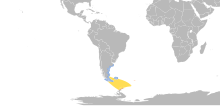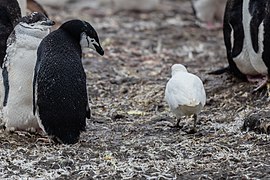Snowy sheathbill
| Snowy sheathbill | |
|---|---|

| |
| Scientific classification | |
| Kingdom: | Animalia |
| Phylum: | Chordata |
| Class: | Aves |
| Order: | Charadriiformes |
| Family: | Chionidae |
| Genus: | Chionis |
| Species: | C. albus
|
| Binomial name | |
| Chionis albus Gmelin, 1789
| |

| |
| Synonyms | |
| |
The snowy sheathbill (Chionis albus), also known as the greater sheathbill, pale-faced sheathbill, and paddy, is one of two species of sheathbill. It is usually found on the ground. It is the only land bird native to the Antarctic continent.[3]
Description[]
A snowy sheathbill is about 380–410 mm (15–16 in) long, with a wingspan of 760–800 mm (30–31 in). It is pure white except for its pink, warty face; its Latin name translates to "snow white".[4]
Sheathbills spend 86% of their day hunting for food and the other 14% resting. [5]
Range[]
The snowy sheathbill lives in Antarctica, the Scotia Arc, the South Orkneys, and South Georgia. Snowy sheathbills living very far south migrate north in winter.[3]
Feeding[]
The snowy sheathbill does not have webbed feet. It finds its food on the land. It is an omnivore, a scavenger, and a kleptoparasite and will eat nearly anything. It steals regurgitated krill and fish from penguins when feeding their chicks and will eat their eggs and chicks if given the opportunity. Sheathbills also eat carrion, animal feces, and, where available, human waste. It has been known to eat tapeworms that have been living in a chinstrap penguin's intestine.[4]
Sheathbills that are actively hunting for food spend approximately 38% of the day hunting, 20% of the time eating their prey, 23% just resting, 14% doing various comfortable activities, and the final 3% will be towards agonistic behavior. [6]
Gallery[]

Flying sheathbill

This snowy sheathbill is watched carefully as they are predators of penguin chicks and eggs

Eating regurgitated penguin chick food

Snowy sheathbill walks by an Antarctic fur seal, at Cooper Bay, South Georgia

Adult snowy sheathbill, on Barrientos Island
References[]
| Wikimedia Commons has media related to Chionis alba. |
| Wikispecies has information related to Chionis alba. |
- ^ BirdLife International (2017). "Chionis albus". IUCN Red List of Threatened Species. 2017: e.T22693556A118854999. doi:10.2305/IUCN.UK.2017-3.RLTS.T22693556A118854999.en. Retrieved 12 November 2021.
- ^ The Internet Bird Collection. "Pale-faced Sheathbill (Chionis alba)".
- ^ a b Briggs, Mike; Briggs, Peggy (2004). The Encyclopedia of World Wildlife. Parragon Publishing. ISBN 1-4054-3679-4.
- ^ a b Lynch, Wayne (September 26, 2001). The Scoop on Poop. Fifth House Books. ISBN 1-894004-59-0.
- ^ Favero, Marco (1996). "Foraging Ecology of Pale-Faced Sheathbills in Colonies of Southern Elephant Seals at King George Island, Antarctica (La Ecología de la Alimentación de la Chionis alba en los Harenes de Elefantes Marinos en la Isla King George, Antarctica)". Journal of Field Ornithology. 67 (2): 292–299. JSTOR 4514110.
- ^ Favero, Marco (1996). "Foraging Ecology of Pale-Faced Sheathbills in Colonies of Southern Elephant Seals at King George Island, Antarctica (La Ecología de la Alimentación de la Chionis alba en los Harenes de Elefantes Marinos en la Isla King George, Antarctica)". Journal of Field Ornithology. 67 (2): 292–299. JSTOR 4514110.
- IUCN Red List least concern species
- Birds of Antarctica
- Chionis
- Birds of islands of the Atlantic Ocean
- Birds of subantarctic islands
- Graham Land
- Birds described in 1789
- Taxa named by Johann Friedrich Gmelin
- Charadriiformes stubs





